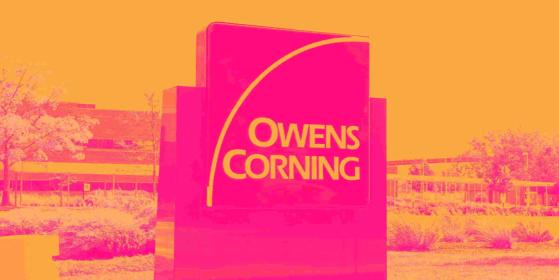Stock Story -
Building and construction materials manufacturer Owens Corning (NYSE:OC) fell short of analysts' expectations in Q2 CY2024, with revenue up 8.8% year on year to $2.79 billion. It made a non-GAAP profit of $4.64 per share, improving from its profit of $4.25 per share in the same quarter last year.
Is now the time to buy Owens Corning? Find out by reading the original article on StockStory, it's free.
Owens Corning (OC) Q2 CY2024 Highlights:
- Revenue: $2.79 billion vs analyst estimates of $2.92 billion (4.6% miss)
- EPS (non-GAAP): $4.64 vs analyst estimates of $4.35 (6.8% beat)
- Gross Margin (GAAP): 31.1%, up from 30.2% in the same quarter last year
- Adjusted EBITDA Margin: 26.6%, in line with the same quarter last year
- Free Cash Flow of $336 million is up from -$128 million in the previous quarter
- Market Capitalization: $14.24 billion
Credited with the discovery of fiberglass, Owens Corning (NYSE:OC) supplies building and construction materials to the United States and international markets.
Home Construction MaterialsTraditionally, home construction materials companies have built economic moats with expertise in specialized areas, brand recognition, and strong relationships with contractors. More recently, advances to address labor availability and job site productivity have spurred innovation that is driving incremental demand. However, these companies are at the whim of residential construction volumes, which tend to be cyclical and can be impacted heavily by economic factors such as interest rates. Additionally, the costs of raw materials can be driven by a myriad of worldwide factors and greatly influence the profitability of home construction materials companies.
Sales GrowthA company's long-term performance is an indicator of its overall business quality. While any business can experience short-term success, top-performing ones enjoy sustained growth for multiple years. Regrettably, Owens Corning's sales grew at a mediocre 6.7% compounded annual growth rate over the last five years. This shows it couldn't expand in any major way and is a tough starting point for our analysis.
Long-term growth is the most important, but within industrials, a half-decade historical view may miss new industry trends or demand cycles. Owens Corning's recent history shows its demand slowed as its annualized revenue growth of 3.1% over the last two years is below its five-year trend.
This quarter, Owens Corning's revenue grew 8.8% year on year to $2.79 billion, missing Wall Street's estimates. Looking ahead, Wall Street expects sales to grow 26.1% over the next 12 months, an acceleration from this quarter.
Operating MarginOwens Corning has been an optimally-run company over the last five years. It was one of the more profitable businesses in the industrials sector, boasting an average operating margin of 14%. This result was particularly impressive because of its low gross margin, which is mostly a factor of what it sells and takes huge shifts to move meaningfully. Companies have more control over their operating margins, and it's a show of well-managed operations if they're high when gross margins are low.
Analyzing the trend in its profitability, Owens Corning's annual operating margin rose by 20.5 percentage points over the last five years, showing its efficiency has meaningfully improved.
This quarter, Owens Corning generated an operating profit margin of 16.4%, down 2.6 percentage points year on year. Since Owens Corning's operating margin decreased more than its gross margin, we can assume the company was recently less efficient because expenses such as sales, marketing, R&D, and administrative overhead increased.
EPSWe track the long-term growth in earnings per share (EPS) for the same reason as long-term revenue growth. Compared to revenue, however, EPS highlights whether a company's growth was profitable.
Owens Corning's EPS grew at an astounding 27% compounded annual growth rate over the last five years, higher than its 6.7% annualized revenue growth. This tells us the company became more profitable as it expanded.
We can take a deeper look into Owens Corning's earnings quality to better understand the drivers of its performance. As we mentioned earlier, Owens Corning's operating margin declined this quarter but expanded by 20.5 percentage points over the last five years. Its share count also shrank by 19.6%, and these factors together are positive signs for shareholders because improving profitability and share buybacks turbocharge EPS growth relative to revenue growth.
Like with revenue, we also analyze EPS over a more recent period because it can give insight into an emerging theme or development for the business. For Owens Corning, its two-year annual EPS growth of 16.1% was lower than its five-year trend. We still think its growth was good and hope it can accelerate in the future.
In Q2, Owens Corning reported EPS at $4.64, up from $4.25 in the same quarter last year. This print beat analysts' estimates by 6.8%. Over the next 12 months, Wall Street expects Owens Corning to grow its earnings. Analysts are projecting its EPS of $15.62 in the last year to climb by 4.2% to $16.28.
Key Takeaways from Owens Corning's Q2 ResultsIt was good to see Owens Corning beat analysts' EPS expectations this quarter. On the other hand, its revenue unfortunately missed. Overall, this quarter could have been better. The stock remained flat at $164.35 immediately after reporting.
